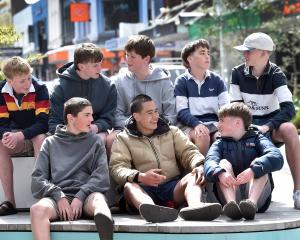Under grey skies, but in fine weather and mild for the season of the year, the visit of a section of the United States fleet to Dunedin drew to a close yesterday afternoon. The flags that waved their welcome from a thousand poles 10 days ago signalled a most cordial farewell on the light southerly breeze. In these few days the officers and men of the fleet have won a lasting place in the friendship and esteem of the people of this city. The visit, it is universally admitted, has been an unqualified success; the pessimists and prophets of trouble have been confounded and silenced by the exemplary conduct and frank friendliness of the visitors. If it was a large and friendly crowd that welcomed the ships, it was a crowd five or six times as large and vastly more friendly that gathered at the wharves and remained about them for hours yesterday in order to catch the last possible glimpse of the visitors and fittingly speed the parting guests. At the wharves most of the destroyers had many visitors aboard in the morning, and numerous intimate little groups could be seen enjoying the "sweet sorrow" of parting. Many a keepsake and token of fond remembrance was exchanged, and cameras were kept busy recording select little groups. Yesterday was not declared a half-holiday, but the crowds that thronged the wharves from 1 o’clock till 4 showed that it was to all intents and purposes being observed as such. There may have been one or two left about to keep open the shops, but it is safe to say that they found very little business to occupy their attention throughout the afternoon. Shortly before 1pm the vessels began to move off in exactly the reverse of the order of their arrival. Assisted by the tugs Dunedin and Plucky, which had a very busy afternoon of it, the destroyer J.F. Burnes 299, the outer one of these berthed nearest the flagship Melville, was the first to move off. She was followed in order by the Somers and Percival, the Moody, the Sinclair, and McDermut, the Burns, the Ludlow, the Paul Hamilton and the Stoddert, the Farquhar, the Thompson, the Kennedy, and last of all the flagship of the Eleventh Destroyer Squadron, the Decatur. As the vessels passed Port Chalmers, Port Chalmers District High School had about 400 of his pupils assembled in a conspicuous position. The sailors answered them cheer for cheer. Several sailors failed to leave Dunedin yesterday by the ships to which they belong. It will be necessary for them to report at the office of the United States consular agent, by whom arrangements will be made to send them to Wellington to-morrow.
Koala all at sea
"Teddy," the Australian bear mascot of the United States destroyer Sinclair, occupied a prominent place on the ship as she left her berth at the Rattray street wharf yesterday afternoon.
A thoughtful sailor gently placed Teddy on the gun on the after deck, and there the little fellow remained throughout the animated scene. The sun’s rays, which burst occasionally through the light clouds, beamed on Teddy’s back.
This was all to his taste. He became drowsy after gazing round for a while, and folding his head in his fore paws, he fell asleep — or at least appeared to be asleep.
However, he had a rude awakening, for when a blast was blown from the Sinclair’s whistle Teddy came to life, and his eyes blinked with fright as he gazed round to ascertain the cause of the unusual noise. — ODT, 21.8.1925
Compiled by Peter Dowden













